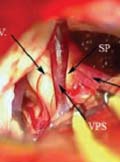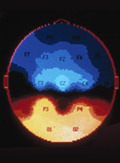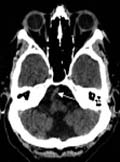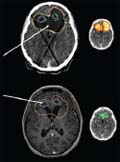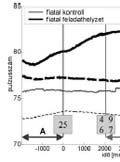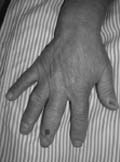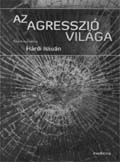The eLitMed.hu medical portal uses computer cookies for convenient operation. Detailed information can be found in the Cookie-policy.
Clinical Neuroscience - 2011;64(01-02)
Content
[Vascular compression syndromes of the cranial nerves]
[The blood vessels which are running nearby the cranial nerves and the brainstem can be elongated; curves and loops of the vessels may develop mostly due to the degenerative alterations of ageing and these vessels can compress the surrounding neural elements. The authors report a review of vascular compression syndromes based on the literature and their own experience. The typical clinical symptoms of the syndromes subserving the proper diagnosis, the pathomechanism, the significance of imaging especially the magnetic resonance angiography, the experience with the surgical technique of microvascular decompression which is the only causal treatment of the syndromes are discussed. In cases of non-responsible medical treatment the microvascular decompression should be the eligible treatment in certain syndromes (trigeminal and glossopharyngeal neuralgia, hemifacial spasm) for it is a highly effective and low risk method.]
[EEG investigations in cognitive impairments]
[The EEG is an indicator of all physiological and neuropsychological activity. The α rhythm was considered as a key phenomenon in research of human mentation from the discovery of EEG. Two methods are known for the estimation of cognitive deficit by the use of quantitative EEG (QEEG). The first is based on the hypothesis, that the mean values of the normal EEG from healthy volunters can be used as reference, and deviation from the normal values of EEG parameters may suggest disease. This kind of “neurometry” was elaborated by R. E. John. The second method asseses event related (ER) transients evoked by somatosensory and mental stimuli. Quantity and localization of signals may refer to the functional state of the cortex. These reactions depend strongly on the test-paradigms. Recognition of the attention-intention cycle disclosed the psysiological mechanism of ERD (event related desynchronisation) and ERS (event related synchronisation). In contrast with the classical “stimulus-reaction” model, both perception and voluntary movement are iniciated by the brain itself, and not by the environment. Human behavior and conscious actions depend on the intention. QEEG analysis proved that the attention and intention localize in segregate areas of the brain. Both “static” and “dinamic” neurometric methods are able to differenciate the EEG records of demented patients from healthy controls, furthermore some dementias from each other. We conclude that with the help of sofisticated methods of QEEG analysis minimal functional deficit of the electrogenesis can be recognized, which could be helpful in the differential diagnosis Notwithstanding the EEG can not explain the evolution neither the normal or the diseased mental processes. The only “instrument” which is able to approach the human mind is the human cogitation itself with the aids of appropriate tests. The QEEG can be conclusive in the analysis of particular processes of mental activity, such as timing, state of activation, hierarchical organisation of cortical territories and mechanism of electrogenesis.]
[Tolosa-Hunt syndrome]
[Both men and women are affected by the rare disease called Tolosa-Hunt syndrome. We don’t know exactly what causes it to evolve. It is usually put into the categories of either idiopathic inflammation or pseudotumor. Its patological feature is a non-specific inflammatory process with fibroblastic, lymphocytic, plasmocytic infiltration, which can be found, for the most part, in the wall of the sinus cavernosus. Granulocytic and giant-cell infiltrations have been described too. The possibility of autoimmune disease has also come up. In our current study we describe the case of a female patient who recovered with the help of a steroid therapy. Through examining her, we also found immunological alterations, which should urge us to thoroughly examine the further observations of this kind.]
[Neurological complications of Fabry-disease]
[Background - Fabry-disease (FD) is a rare X-linked lysosomal storage disease. Deficiency of alpha-galactosidase A activity leads to the accumulation of neutral glycosphingolipids, primarily globotriaosylceramide (GL-3) in various tissues, particularly blood vessels, kidneys, myocardium and in ganglions of the peripheral and autonomic nervous system and causes diverse symptoms. The classical phenotype is seen in most males and rarely in females. In women, symptomes start later and the severity is milder. Both peripheral and central nervous system can be both affected. Objectives - Fabry-patiens and gene-carriers in the central region of Hungary are treated in the 2nd Pediatric Department, Semmelweis University. These patients are consulted by an interdisciplinary team. At present, four hemizygous male, four heterozygous female Fabry-patients and three asymptomatic heterozygous gene carriers are followed. Results - After reviewing the neurological complications of FD, we present clinical and neuroimaging data of our patients. Conclusion - We emphasize that neurologists should suspect the rare monogenic FD in the case of acroparaesthesia and heat-cold intolerance in childhood or adolescence; clinical signs of TIA/stroke or unexplained MRI alterations suggesting small vessel disease in young adults. Early diagnosis and introduction of enzyme replacement therapy (ERT) can halt or reverse progression.]
[Dinamics of craniopharyngeomas reduction after Yttrium-90 colloid brachytherapy]
[Objective - The aim of this study is to reveal the long-term effect of Yttrium-90 colloid radioisotope brachytherapy applied for the treatment of cystic craniopharyngiomas. To provide a mathematical expression that can describe the cyst reduction as a function of time in an accurate matter. Methods - Fourteen cystic craniopharyngiomas were selected for intracavital irradiation with stereotactically implanted beta-emitting radioisotope Yttrium-90 silicate colloid. The cumulative dose aimed at the inner surface of the cyst wall was ranging between 180-300 Gy. Volumes of the cysts were measured on image-fused control CT/MRI images for a 28-month period. Dose planning was done with our own software, while stereotactic calculations, volume calculations and image fusion were done with the BrainLab Target 1.19 software. Mathematical and statistical computations were carried out with the Matlab numeric computation and visualization software. To determine the volumes, the control images were fused with the planning images. Results - Relative volumes normalized with respect to the volume of cysts before irradation were determined from the patients’ measured data, the mean values of volumes were calculated, then a polynomial was fitted to the mean values using the polynomial curve fitting method. We have found that the dynamics describing the reduction of cysts can be expressed mathematically by the polynomial V=93.627-18.091t+1.473t2-0.054t3+0.0007t4, where „t” denotes the time in months passed after irradiation. The accuracy of our results was verified by correlating the predicted data with the measured ones. Conclusions - Our long-term results support the view, that intracavitary Yttrium-90 irradiation is a non invasvive and very effective method for treatment of craniopharyngioma cysts. The derived polynomial helps to 1. design the best treatment, 2. follow up patients’ condition and 3. plan a reirradiation if necessary.]
[Ageing and arithmetic performance - electrophysiological complexity-, and graph theoretical characteristics]
[During the course of ageing the decline of cognitive performance, including attention and working memory processes - essential for arithmetic procedures - is well known. For the investigation of the neuronal mechanisms of these processes the application of methods capable of taking into account the high complexity of the nervous system, the role of nonlinear processes and network-properties of its constituents are necessary. As for the latter the recently realized small world network characteristics representing optimal conditions for information processing may be of particular importance. In the present study the spectral, complexity-, and network characteristics of the EEG recorded during performing an arithmetic task in a group of young (n=32, mean age 22.0 yrs) and elderly (n=19, mean age: 66.7 yrs) was analyzed. Heart rate and behavioral measures (number of mistakes, reaction time) were also investigated. The alpha2 band decreased in the young, while the delta band increased in the elderly in the task condition. The increased Omega-complexity observed in the elderly is probably caused by reduced interneuronal connectivity. “Small-world” network characteristics were found in the beta and delta bands although in the elderly the topology was closer to a random pattern. In the task condition the network features of the elderly subjects shifted more towards the small world pattern than those seen in the young indicating that for the elderly the mobilized effort for task completion was higher. In spite of this, the level of performance and the heart rate change observed in the elderly was lower than that seen in the young. The application of complexity-, and graph theoretical analysis appears to be a promising tool for the investigation of diseases of the nervous system characterized by diffuse pathology as in the case of as various types of dementias.]
[Ulcerative carpal tunnel syndrome]
[The carpal tunnel syndrome is the most frequent compression-induced neuropathy. A severe but rare clinical manifestation of this disorder associates with ulceration, acral osteo-lysis and mutilation of the terminal phalanges of the second and third fingers. Recognition of this disorder is difficult, because various dermatological and internal diseases might lead to acral ulcerative lesions, and these patients are seldom referred to neurological and/or electrodiagnostic examination. In this article, we present three cases of this rare clinical form of carpal tunnel syndrome and discuss the electrodiagnostic findings. The early diagnosis is important since decompression of the median nerve in due time might prevent mutilation and could significantly improve the patients’ quality of life.]
[ULCERATIVE CARPAL TUNNEL SYNDROME]
[The carpal tunnel syndrome is the most frequent compression- induced neuropathy. A severe but rare clinical manifestation of this disorder associates with ulceration, acral osteolysis and mutilation of the terminal phalanges of the second and third fingers. Recognition of this disorder is difficult, because various dermatological and internal diseases might lead to acral ulcerative lesions, and these patients are seldom referred to neurological and/or electrodiagnostic examination. In this article, we present three cases of this rare clinical form of carpal tunnel syndrome and discuss the electrodiagnostic findings. The early diagnosis is important since decompression of the median nerve in due time might prevent mutilation and could significantly improve the patients’ quality of life.]
[Paroxysmal kinesigenic dyskinesia]
[Paroxysmal kinesigenic dyskinesia (PKD) is a rare neurological disease and the diagnosis is based on case history and clinical features. Despite of simply diagnostic criteria, the recognition of the disease is sometimes delayed. The involuntary movements in PKD lead to anxiety, social isolation, trauma and worsens the quality of life. To establish the diagnosis many other paroxysmal syndromes have to be excluded. The disease responds to antiepileptic therapy well. The genetic background of the familiar cases is not known. Here we present a 19 year-old patient with PKD and review the current literature. Our patient’s events were triggered by sudden movements and last several seconds. His physical and neurological examinations were normal and responded well to carbamazepine therapy.]
[Some thoughts about the presumed death of classical neurology and the neurology to come]
[In my opinion Hungarian medicine, and not just neurology, is in a critical state. This is the consequence of various factors, such as the overemphasizing of medicine’s economic aspects, the malfunctions of patient care caused by inadequate source allocation, and the misinterpretation of the doctors’ role by the society. The vastly increased knowledge base and the huge amount of information we can gather about our patients are an unparalleled chance, rather than a deathly wound, for neurology as a discipline. The challenge the future’s neurology has to face is high-quality patient care, which necessitates dedicating the necessary time for patients, rationally using our ever-increasing diagnostic arsenal, and continuously updating our knowledge about the therapeutic possibilities.]
[Organization of rehabilitation of people with disabilities as a consequence of neurological conditions in Hungary]
[The history of rehabilitation of people with disabilities as a consequence of neurological conditions goes back to more than four decades in Hungary. The authors describe its history, how this service is organized nowadays, questions of specialization, scientific activity and quality improvement. They emphasise: any form of neurorehabilitation service (special neurorehabilitation department or programme of a multiprofile rehabilitation unit) must meet the same criteria. Quality assurance will be provided by a new accreditation system.]
1.
Clinical Neuroscience
[Headache registry in Szeged: Experiences regarding to migraine patients]2.
Clinical Neuroscience
[The new target population of stroke awareness campaign: Kindergarten students ]3.
Clinical Neuroscience
Is there any difference in mortality rates of atrial fibrillation detected before or after ischemic stroke?4.
Clinical Neuroscience
Factors influencing the level of stigma in Parkinson’s disease in western Turkey5.
Clinical Neuroscience
[The effects of demographic and clinical factors on the severity of poststroke aphasia]1.
2.
Clinical Oncology
[Pancreatic cancer: ESMO Clinical Practice Guideline for diagnosis, treatment and follow-up]3.
Clinical Oncology
[Pharmacovigilance landscape – Lessons from the past and opportunities for future]4.
5.
